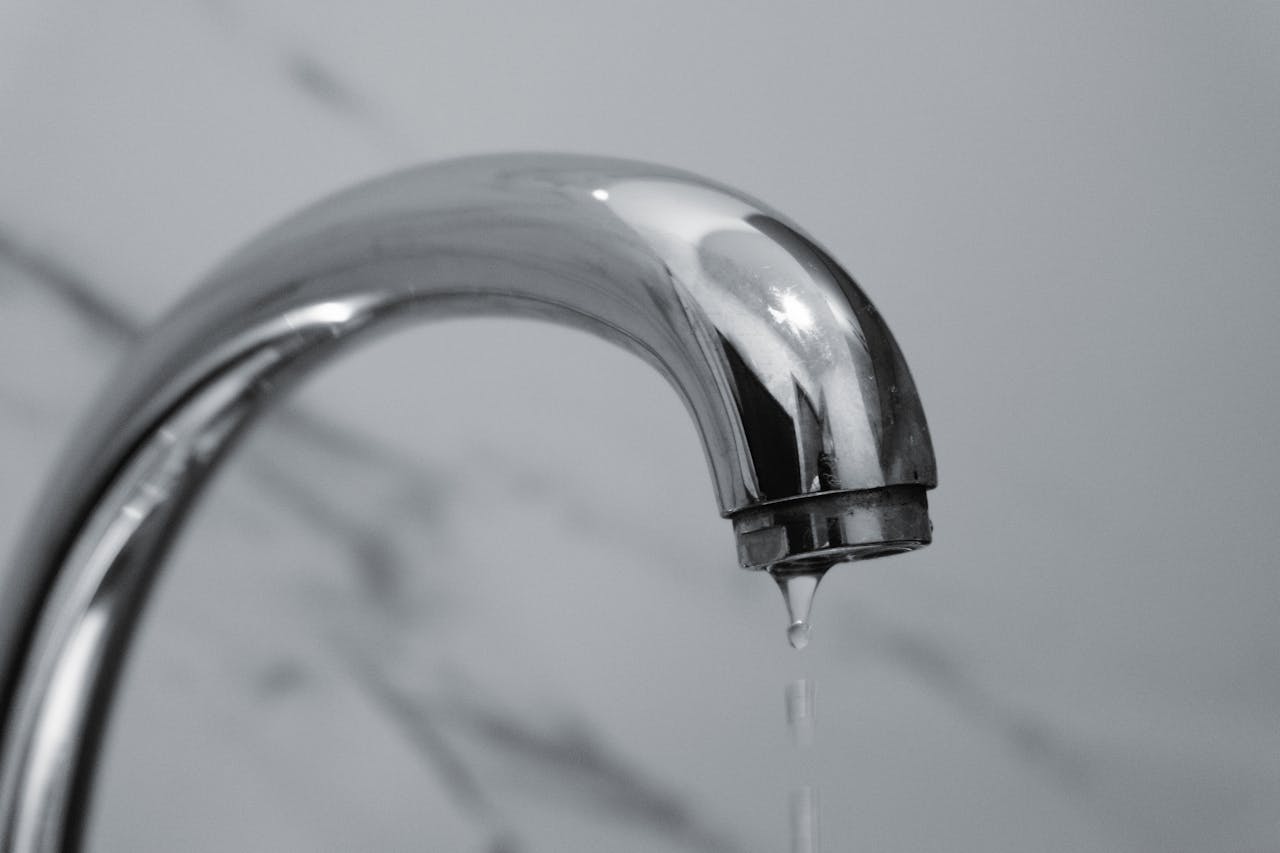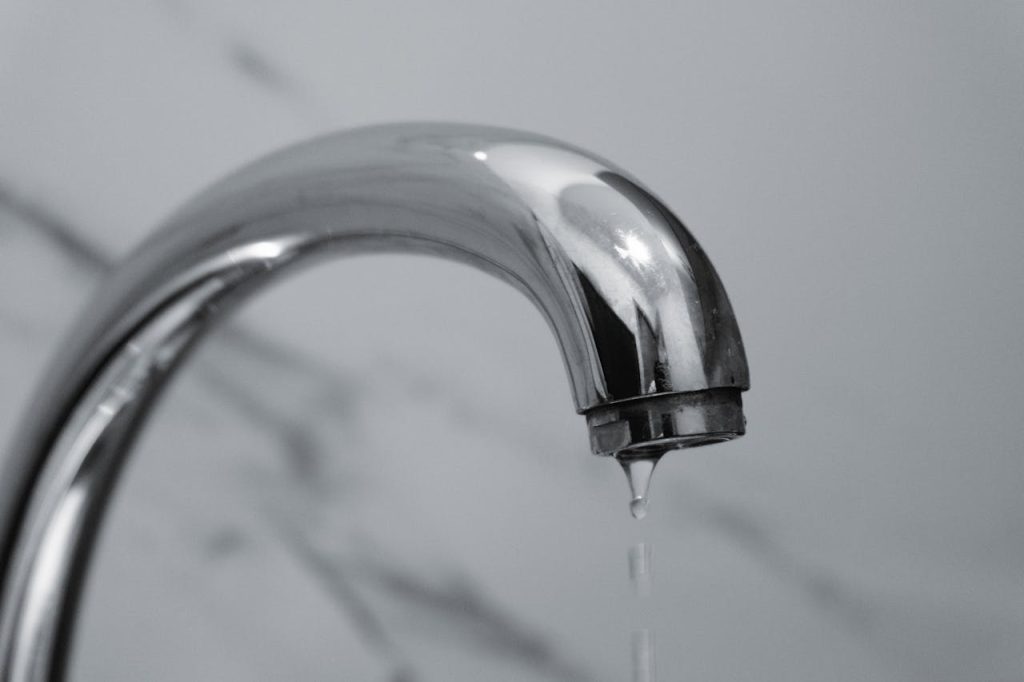Key Takeaways
- Kitchen faucets in Santa Rosa often leak due to several common issues. The main causes include hard water, worn gaskets, O-ring failures, and corroded valve seats. To prevent these leaks from recurring, regular maintenance is crucial.
- Frequent checkups and prompt replacement of gaskets and O-rings minimize leak risk and extend the life of your kitchen faucet.
- Timely leak diagnosis by inspecting all faucet parts, tracking drips, and listening for irregular noise assists in avoiding water loss and possible structural damage.
- Neglecting even the smallest of faucet drips can lead to unbearable water bills, expensive property damage, and needless environmental waste. This makes early intervention crucial.
- Basic fixes like tightening connections or changing washers can be managed as DIY projects, but serious problems, such as valve seat corrosion, should be handled by licensed plumbers for dependable, long-term results.
- With these preventive steps, implementing scheduled cleaning, using the faucet gently, and potentially installing a water softener, you can avoid future leaks and save your household expenses and resources.
A leaky kitchen faucet in Santa Rosa means slow drips, wasted water, and increased bills in many homes. Since nearly all leaks begin with worn washers or aged seals in both new and old kitchens, Santa Rosa water costs and local regulations mean that quick fixes are wise for anyone who is saving money or wants to stay away from major plumbing trouble. As most homes in the area have standard single or double-handle faucets, it’s generally easy for most people with simple tools to fix. To assist, this post outlines easy instructions, standard components, and advice for repairing leaks quickly. Readers will get straightforward tips and what to check before dialing up a plumber. The following part reveals the tools and procedure.

Why Santa Rosa Faucets Leak
Santa Rosa kitchen faucet leaks are a common problem, sometimes due to a combination of factors. Hard water, old parts, and shoddy installation all contribute. Above the annoyance, leaks can waste thousands of liters of water annually and increase household bills, particularly in drought-conscious areas. Identifying these common reasons is essential for prevention and repair.
Hard Water Issues
Hard water is a common culprit. It contains high mineral content, primarily calcium and magnesium. Over time, these minerals accumulate inside faucet aerators and valves. These deposits can clog and restrict water flow, create uneven pressure, and wear down internal seals, resulting in leaks. The buildup is worse in older homes with legacy pipes, where mineral scale can clog constricted spaces and wear out the rubber washers inside.
- For goodness’ sake, add a water softener system to neutralize the minerals before they even get to your faucets or toilets.
- Clean faucet aerators once a month to remove visible deposits and keep the flow steady.
- Test your tap water hardness with commercial kits and adjust treatment systems accordingly.
- Have it professionally inspected yearly to identify mineral buildup early and address it.
By observing water quality and employing softeners, you can slow down buildup and decrease the chance of leakage.
Gasket Wear
Gaskets seal the gap between moving parts. Water pressure, temperature fluctuations, and everyday usage wear them down over time. Worn gaskets lose their grip and let water slip by, leading to leaks that may be initially minor but can exacerbate if left unattended.
- Examine gaskets during routine faucet checks.
- Look for cracks, warping, or hardening.
- Swap in some high-quality rubber or silicone gaskets and you’re good for a long while!
- Keep an eye on your gasket age and replace them every couple of years for optimal performance.
Gasket wear is among the most common causes of drips that won’t quit.
O-Ring Problems
O-rings are little rubber circles that prevent water from weeping around the spout. They often give out because they’re old, stretched, or don’t fit right. When O-rings become brittle or misaligned, leaks emerge around the base or handle.
Look for swelling or cracks. Use only the correct size and type for your particular faucet model. Be sure to always seat O-rings properly when installing. A poor fit can cause leaks to bounce right back. Routine O-ring changes are a quick fix that can save hundreds of liters a month.
Valve Seat Corrosion
Valve seat corrosion is a covert yet dire issue. It occurs when water accumulates in contact with metal components for an extended period, particularly if the water is hard or acidic. Corroded valve seats can’t seal tightly, so water leaks from the spout even when the faucet is off.
Cleaning valve seats does help, but if they’re heavily corroded, replace the seat. For complicated repairs, contact a professional plumber to prevent additional damage. Repairing valve seat corrosion quickly gets your faucet operating optimally again and reduces secret water loss.
How To Diagnose Your Leaky Faucet
A systematic approach is the key to diagnosing your leaky kitchen faucet. Your initial action is to determine if your faucet is a two-handle conventional compression type or a one-handle cartridge type, as this will influence how you diagnose and fix it. Turn off the water at the valves before you take anything apart. Even a drip, with the handle fully closed, indicates a leak. Signs such as increases in water bills or water visibly pooling are classic warnings.
1. Pinpoint The Source
Begin by following the water to determine whether it’s leaking from the faucet itself or the plumbing. Perform a visual and manual inspection of the faucet head, handles, and under the sink for moisture. A flashlight comes in handy for peering behind the sink or into the cabinet. Document your discovery—water stains or rust aren’t subtle things—so you can describe them to a plumber if necessary. This systematic approach guarantees you won’t miss sneaky leaks that can get worse.
2. Check The Handles
If a handle is loose, give it a gentle tightening. Loose handles are the culprit of small leaks and are easy to repair. Check inside the handle for worn washers or damaged cartridges. These are common offenders. Stiff or jerky handles indicate internal wear, and replacing the washer or cartridge can bring back smooth operation. Often, repairing the handle is all it takes to halt the leak and avoid any damage.
3. Inspect The Base
Check in and around the faucet base for water pooling, which can be indicative of a bad seal or loose connection. Look for rust, cracks, or any gaps where the faucet is connected to the sink. Tighten any mounting nuts or screws you find. Scrape out debris, because grime can prevent seals from seating snugly. If you can see corrosion or damage, that frequently indicates that you need either a new seal or an entire replacement.
4. Listen For Sounds
If it makes a dripping sound when it is turned off, you’re dealing with a leak. Hissing or sputtering could indicate water pressure problems or deteriorated internal components. Attempt to localize the noise by listening beneath the sink and at the base of the faucet. Make note of what you hear. This detail aids plumbers in troubleshooting and accelerates repairs.
5. Note The Drip Rate
How many drops a minute? Even small drips can unnecessarily squander hundreds of liters per month and increase costs. To diagnose your leaky faucet, if the drip rate goes up, it might be getting worse. Fixing a leak yourself early on, before it becomes a plumbing emergency, saves you money on water and repair bills. Labor can be $200 an hour, and parts can be as much as $150.
The Hidden Costs Of A Drip
A dripping kitchen faucet may seem innocent, but the consequences stack up quickly. Even a drip a second can waste over 3,000 gallons a year. The real costs go beyond wasted water and have a deeper impact on your wallet, your home, and the environment.
Water Bill Impact
Every drip contributes to your tab. A faucet dripping at one gallon per hour wastes 24 gallons a day, which is around 720 liters every month. This innocuous-looking drip can add anywhere from $6 to $70 or more each month, depending on local rates. For multi-faucet families, this adds up and stretches budgets over time.
Watching your water use is essential, especially when your bill shoots up. A stream slowly increasing to 100 gallons, roughly 378 liters a day, can waste enough water for dozens of daily showers in only a week. Small drips, if not monitored, turn into expensive drips over months.
Potential Water Damage
Leaks do more than increase costs. Water can permeate into cabinets and flooring, causing wood to distort or deteriorate. Countertops, if exposed long enough, can stain or even rot. These repairs tend to cost a lot more than repairing the faucet initially.
Mold and mildew live in wet places. Even a slow drip gives them the moisture they require. Mold introduces health issues and is difficult to get rid of once established. Preventive actions, such as promptly repairing leaks and inspecting areas beneath sinks, can assist in catching more substantial problems at the outset.
Environmental Waste
A dripping tap wastes 5 gallons a day from just a single slow drip. Across a city or region, the aggregate waste is enormous. Even where water is abundant, saving it still counts for tomorrow.
Immediate fixes safeguard community reservoirs. Every family that stops a drip contributes to widespread savings. Spreading this information gets other people to realize how little acts stop waste and keep us living sustainably.
Cost Type | Example Value (USD) | Example Volume (Liters) | Environmental Impact |
Monthly Water Bill | $6–$70+ | 2,700–11,350 | Water supply strain |
Water Damage Repair | $200–$5,000+ | — | Resource-intensive repairs |
Annual Water Wasted | — | 11,350–32,000 | Reduced freshwater reserves |

Diy Repair Vs. Professional Help
When to DIY vs. Call a Pro: Whether you should fix a dripping kitchen faucet yourself or call an expert depends on understanding the complexity of the problem, your skill level, and the potential risks. Repairs range from easy to those requiring specialized skills, so understanding what you’re up against is important for any Santa Rosa repair.
When To DIY
Basic faucet fixes, such as swapping out an O-ring, changing a washer, or tightening a loose connection, are frequently accessible to the majority of individuals. If you’re observing a slow drip or a small leak at the base, you may only need a flathead screwdriver, adjustable pliers, or a utility knife. Replacement parts like faucet cartridges or gaskets are typically readily available at hardware stores and often cost less than $10. These fixes are easy to do, take under an hour, and save you a boatload of labor costs.
There are step-by-step instructions online and in videos for a variety of faucet models. Clear directions reduce errors, particularly if you’re a rookie. It’s crucial to evaluate the leak severity before initiating. If water is only dripping and not pooling, then it may be an easy repair. If the leak gets worse after your effort, it’s probably best to call it a day.
They’re best for small problems. If you’re handy with a wrench and not afraid to shut off the water, these repairs can be immediate and straightforward. They can do more harm than good if improperly repaired, leaking behind walls or under sinks. This can result in repairs that are way more expensive than the original issue.
When To Call A Pro
When the problem extends beyond simple upkeep, like corrosion on the valve seat or leaks that return soon after repair, you need a pro. Licensed plumbers have the expertise to use specialized tools to diagnose unseen problems and provide a guaranteed repair that minimizes your future risk.
- Complex leaks or persistent drips after DIY attempts
- Visible corrosion or mineral buildup on faucet components
- Unknown source of leak or water under the sink
- Older plumbing or specialty fixtures that require expert handling
Professional help doesn’t come cheap. Labor alone can run upwards of $200 an hour, with parts costing anywhere from a few bucks to $100, depending on your faucet. It’s prudent to get at least three estimates from decent plumbers. Sure, it costs more up front, but a professional repair is typically more long-lasting and dependable, particularly for complex or subsurface issues.
The Pro Plumber Advantage
The Pro Plumber Advantage Professional plumbers offer an expertise that few homeowners can match, especially when it comes to a leaky kitchen faucet in Santa Rosa. With their expertise, they provide dependable solutions that address the actual issue, not just the symptoms. With a focus on compliance, safety, and transparency, their work results in superior client outcomes. The Pro Plumber Advantage is the value they bring that extends beyond the quick repair, providing peace of mind both short-term and long-term.
Correct Diagnosis
A professional, licensed plumber can identify the real source of a leak with the right tools and techniques. This can translate to looking for worn washers, corroded valve seats, or latent pipe fractures, not simply tightening a handle. More often than not, leaks can be due to a combination of minor problems, like mineral deposits or a leaky gasket, which aren’t necessarily visible to the inexperienced eye. Plumbers know plumbing codes, allowing them to identify non-compliant fixtures or outdated configurations that may be exacerbating the issue.
The Pro Plumber Advantage – They take a wide-angle perspective, viewing the whole system, not just the tap. This guarantees that nothing falls through the cracks, and homeowners don’t pay for the same fix again and again. Specialized tools, such as pipe locators or basin wrenches, help plumbers navigate complex plumbing systems to deliver expert repairs.
Lasting Repairs
A pro plumber doesn’t make expedient fixes. Instead, they rely on quality components and battle-tested techniques to make sure fixes stick. This minimizes the odds of that very same leak popping up again and saves you time and money down the road. They provide warranty work to standard, utilizing components appropriate for the specific model and brand of the faucet, thereby avoiding compatibility problems. Homeowners who settle for band-aid repairs end up paying more in water damage or return service visits.
Regular attention from a pro detects trouble early, increasing your faucet’s service life. Reliable repairs are part of the wider benefit of hiring a pro. You get peace of mind knowing the job is done right.
Warranty And Peace
Professional plumbing typically has clear warranties. If a leak should return within the warranty period, that plumber will come back and repair it at no additional charge. That promise is supported by their licensing and insurance, which shield homeowners from liability if damage or injury occurs during repairs. Warranties translate to no surprise expenses should the same problem come back, which isn’t true for most do-it-yourself or unlicensed fixes.
It helps to know that your plumber is available 24/7 in an emergency. Transparent pricing and clear communication contribute to the trust and comfort homeowners experience after hiring a licensed professional.
Preventing Future Faucet Leaks
Minimizing kitchen faucet leaks is not simply reactive; it’s proactive. Neglect results in water waste, mold, and more expensive repairs. A few tweaks to routine behavior and consistent maintenance can stave off leaks, conserving both time and material.
- Create a weekly or biweekly cleaning routine for faucets.
- Remove mineral deposits with vinegar or a mild cleaner.
- Wipe handles and spouts to clear grime.
- Check screws and aerators for tightness and clogs.
- Request everyone in the household to adhere to the scrubbing schedule.
Regular Cleaning
Regular cleanings prevent mineral deposits and dirt from accumulating, which can break down seals and cause leaks. Use mild cleaners or diluted vinegar so you don’t damage the finish. A soft brush or cloth works great for scrubbing around edges and joints. Mineral buildup from hard water regions causes blockage or slow drips.
While cleaning, inspect the faucet aerator and screen. Unscrew them and wash out any grit or sand. This maintains laminar water flow and prevents pressure from pushing leaks at vulnerable seams. If you don’t live alone, be sure everyone pitches in. When everyone knows how to detect deposits or a loose screw, minor issues get resolved quickly.
Cleaning’s not just for inside. Outdoor faucets and ones in the garage or basement require equal attention. Check for wet spots on the floor, an early sign of leaking. Keep faucets dry and screws tight. Insulate pipes in unheated areas and maintain thermostats at no less than 55°F to avoid freezing and bursting.
Gentle Operation
Educate everyone in the household to twist faucets with caution. Don’t pull or force them. Most leaks begin when handles get pushed too hard or shut off with excessive force. If a handle is stiff or hard to turn, get it repaired early. Don’t wait for failure. Lubricate or replace worn parts before they break.
It assists in discussing why gentle use is important. Handles, cartridges, and seals all wear down quickly when used roughly. Certain families buy new faucet models designed for easy turning, which reduces the chance of damage. They are especially helpful in homes with children and seniors, or anyone with diminished hand strength.
Water Softeners
Hard water accelerates damage to faucet components, increasing the likelihood of leaks. Water softeners exchange minerals for sodium, reducing scale. Here are some common softening systems and their key features:
System Type | Benefits | Cost (USD) |
Salt-based (Ion Exchange) | Reduces calcium and magnesium, easy upkeep | $300–$1,000 |
Salt-free | No salt needed, eco-friendly | $400–$2,000 |
Magnetic/Electronic | No chemicals, simple setup | $100–$400 |
Discover the softener that suits your space, water consumption, and wallet. Have a plumber put it properly, so it plays well with your existing pipes. Once installed, test your water quality every few months. If scale still forms, test the softener for issues or make settings adjustments.
Conclusion
Leaky kitchen faucets in Santa Rosa. Water damage, noise, and increased bills all begin with a drip. Catching leaks early prevents bigger headaches. Easy repairs are fine for minor leaks, but more major tasks require the expert touch. Plumbers understand local parts and water quirks, so they identify root causes quickly. Proper maintenance, such as cleaning and periodic inspections, prevents the majority of leaks before they begin. Replacing old washers saves water and money as well. Require assistance with a stubborn leak? Locate a plumber who knows Santa Rosa homes. Be vigilant, repair those leaks, and let your kitchen hum.
Frequently Asked Questions
1. What Causes Kitchen Faucets To Leak In Santa Rosa?
These can be caused by hard water minerals, worn-out washers, or old seals. Santa Rosa’s water quality and climate can accelerate these problems.
2. Is A Dripping Faucet Expensive To Ignore?
Yes. Even a slow drip can waste hundreds of liters of water a day, increase your utility bills, and damage the environment.
3. Can I Fix A Leaky Kitchen Faucet Myself?
A lot of little leaks are simple to repair with common tools. If you’re unsure or if it continues leaking, expert assistance is best.
4. When Should I Call A Professional Plumber?
Call a plumber if the leak is severe, you see rust, or past DIY fixes didn’t work. Licensed plumbers guarantee a permanent repair and avoid water damage.
5. How Do I Prevent Future Faucet Leaks?
Clean the faucet regularly, test for mineral buildup, and change worn parts immediately. Yearly tune-ups catch issues early.
6. Are All Faucet Leaks Due To Worn Washers?
No. Leaks can come from bad cartridges, damaged O-rings, or corroded valve seats. A technician can determine the precise culprit.
7. Does A Leaky Faucet Affect Water Pressure?
Yes. A leaky kitchen faucet in Santa Rosa can decrease pressure and indicate larger plumbing problems. Taking care of leaks sooner can keep that water flowing well.
Faucet Repair & Kitchen Plumbing In Santa Rosa – Fast, Honest, Local Help
Leaky faucets, low water pressure, or plumbing issues in your kitchen can quickly disrupt your day. Don’t let a small drip or faulty fixture turn into a bigger, costlier problem. The trusted team at Yorkshire Plumbing provides expert faucet repair and kitchen plumbing services to keep your home running smoothly.
With nearly a decade of experience and the right tools for the job, we deliver real solutions, not quick fixes. From repairing worn-out faucets and clearing clogs to upgrading sinks, fixtures, and water lines, our licensed plumbers are ready to help.
Whether you’re dealing with a leaky kitchen faucet, planning a remodel, or facing unexpected plumbing trouble, Yorkshire Plumbing has you covered. Call or message us today for a free estimate. We offer same-day service when possible and are always available for urgent jobs.
Yorkshire Plumbing is your go-to, family-owned team for reliable faucet repair and kitchen plumbing in Santa Rosa.
Disclaimer
The information provided on this website is for general informational and educational purposes only and is not intended as professional plumbing or construction advice. You should consult with a licensed plumber or qualified contractor for guidance specific to your home or situation. Do not rely solely on the content of this site to make decisions about plumbing repairs, installations, or maintenance. While we strive to keep the information current and accurate, it may not reflect the most recent industry standards or code requirements. Yorkshire Plumbing & Drain Services disclaims all liability for any actions taken or not taken based on the content of this site, to the fullest extent permitted by law.






